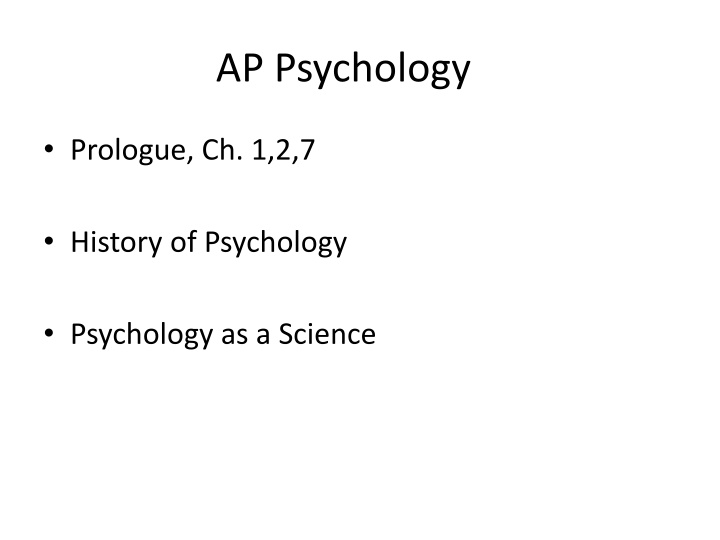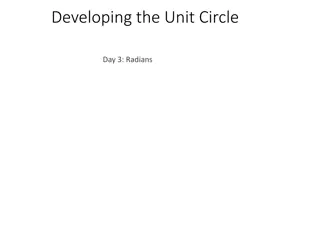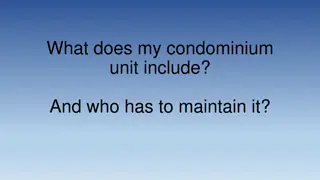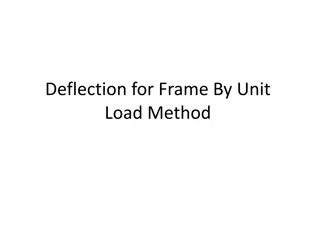
The History and Perspectives of Psychology
Explore the captivating journey of psychology, from its historical roots to the diverse perspectives shaping the science of behavior and mental processes. Delve into the key figures, pivotal studies, and fundamental concepts that define this fascinating field of study.
Download Presentation

Please find below an Image/Link to download the presentation.
The content on the website is provided AS IS for your information and personal use only. It may not be sold, licensed, or shared on other websites without obtaining consent from the author. If you encounter any issues during the download, it is possible that the publisher has removed the file from their server.
You are allowed to download the files provided on this website for personal or commercial use, subject to the condition that they are used lawfully. All files are the property of their respective owners.
The content on the website is provided AS IS for your information and personal use only. It may not be sold, licensed, or shared on other websites without obtaining consent from the author.
E N D
Presentation Transcript
AP Psychology Prologue, Ch. 1,2,7 History of Psychology Psychology as a Science
History of Psychology Psychology-The science of behavior and mental processes Psychology looks at 4 major issues: -rationality vs. irrationality -nature vs. nurture -stability vs. change -observation vs. introspection
Important Figures and Perspectives in Psychology Freud: Believed in Psychoanalytic Theory and that people were products of their subconscious (unconscious) minds. Looked at dreams. Jung: Believed in Analytic Psychology and followed Freud. Was more spiritual. Darwin: Believed in Individual Differences and Survival of the Fittest also known as Natural Selection.
Important Figures and Perspectives Beck, Bandura, Piaget: Believed in Cognitive Psychology-that we are a result of our thoughts and how we view the world. Pavlov, Skinner, Watson, Locke: Believed that we are a result of what we observe, also known as behavioral psychology. Locke believed in tabula rasa or blank slate.
Important Figures & Perspectives Neuroscience Perspective: Emphasizes that behavior is influenced by brain chemistry Adler: Believed in Birth Order and Education Rogers & Maslow: Believed that all people are born good, also known as humanistic psychology.
Experimental Psychology 3 types of studies in psychology: The Survey The Correlation The Experiment
Survey Take opinions on two concepts and see which one has greater support or influence
Correlation Correlations run from -1 to +1 and can be considered positive or negative. The value tells the strength while the sign tells the direction. A positive correlation signifies two items moving in the same direction while a negative correlation signifies two items moving in opposite directions. -.75 is stronger than +.55 -1.0 and + 1.0 are the strongest correlations
Scatterplots Scatterplots show correlation A positive correlation is shown with a line that goes down to the left and up to the right. A negative correlation is shown with a line that goes up to the left and down to the right. A zero correlation has no line that can be drawn.
Experiments While correlations have no cause-effect, experiments do. The experiment proves to show that one variable causes another such as aspirin causing a reduction in headaches. Independent Variable: (IV) Introduced by the experimenter to change the results Dependent Variable: (DV): Measured by the experimenter
Experiments Placebo Effect: Something believed to be causing the results which is really psychological. Random Sample: Ensures everyone in the population has an equal chance to be selected Random Assignment: Equally assigns people to the control and experimental groups reducing the likelihood of preexisting differences.
Experiments Baseline Measurement: Initial value before implementing procedures Post Measurement: Value after implementing procedures Control Group: Group which does not receive the independent variable Experimental Group: Group which receives the independent variable.
Experiments Hawthorne Effect: Researcher bias which affects the experiment Single Blind: When the subject does not know which group the subjects are in. Double Blind: When the subjects and researcher do not know which group the subjects are in.
Ch. 2 - Biology Neural Communication Dendrites Receives information and passes it to the cell body Axons largest part of cell body Myelin Sheath Protects axon and speeds neural impulses
Neural Communication Contd Action Potential Electrical charge traveling down the axon which gives an all or none response Threshold Minimum amount of intensity Synapse Junction between the cells
Neurotransmitters Chemical messages in the brain Acetylcholine (ACH) Enables muscles, learning and memory; not enough leads to Alzheimers Disease Dopamine: Movement, attention, learning & emotion. Too much leads to Schizophrenia and not enough leads to Dopamine
Neurotransmitters Serotonin Mood, hunger, sleep, arousal. Not enough leads to depression Norepinephrine Alertness & Arousal. Not enough can lead to depression Endorphins: Controls pain and pleasure
Nervous System Divided into central & peripheral Peripheral contains the somatic & autonomic Autonomic contains the sympathetic & parasympathetic Somatic controls voluntary movement Autonomic controls involuntary movements Sympathetic controls arousal & prepares you for stress Parasympathetic controls the recovery
Sympathetic N.S. Dilates pupils Increases heart rate Inhibits digestion Stimulates glucose Stimulates adrenaline Relaxes bladder Stimulates ejaculation
Parasympathetic N.S. Contracts pupils Decreases heart rate Stimulates digestion Stimulates gall bladder Contracts bladder Blood flow to sex organs
Endocrine System Hormones Chemical messages in the blood Adrenal Gland Secretes adrenaline Pituitary Gland pea-size structure conrolled by the hypothalamus responsible for growth Hypothalamus Responsible for hunger, thirst, homeostatic balance
Brain Imaging EEG-Electroencephalogram amplified reading of the brain PET Scan Positron Emission Tomography show s brain s chemical fuel MRI Shows spinning atoms of the brain FMRI functional MRI; Can reveal brain s function and structure. Most sophisticated method.
Other Brain Structures Thalamus Telephone switch board Medulla Controls heartbeat & respiration Reticular Formation Controls arousal & alertness Cerebrum Controls higher level thinking
Other Brain Structures Cerebellum Coordinates movement & balance Corpus Callosum Connects the two hemispheres Limbic System (Amygdala) Controls emotion Glial Cells Support, nourish & protect neurons
Brain Lobes Frontal Emotion & Judgement Parietal Sensory Information & touch Occipital Vision Temporal Hearing & Memory Brocha s Area Language Expression (Speech) Wernicke s Area Reception (Comprehension) Aphasia Language Impairment
Final Brain Terms Angular Gyrus Transforms visual representation into auditory codes Plasticity Brain s ability to regenerate itself after damage Right brain vs. Left Brain Left Brain: right handed, logical, mathematical Right Brain: Artistic Ability, Creative, Spatial Relations
Ch. 7 - Consciousness Selective Attention Conscious Awareness Inattentional Blindness When attending to one task, not noticing other obvious stimuli in the background Change Blindness Not noticing obvious change in stimuli
Biological Rhythms Circadian Rhythms 24 hour sleep-wake cycle Sleep Stages 1,2,3,4,Rem Stage 1: (Alpha Waves) relaxed phase Stage 2 (Sleep Spindles) Stage 3 (Theta Waves) Stage 4 (Delta Waves) Deep Sleep
Stage 4 Deep Sleep Sleep talking occurs Sleep walking occurs Enuresis Bed Wetting Encopresis Bed Soiling Night Terrors (Nightmares occur during REM
REM & n-REM As evening progresses, REM increases and n- REM decreases Babies average 50% REM, Adults average 20% REM Rebound Lacking sleep one night will result in an increased REM the following night. Sleep Medications reduce REM and speed individual to stage 4. Stopping increases REM and nightmares.
Final Sleep Terms Teens need 8-9 hours on average Hallucination Sensory experience without a stimulus Narcolepsy Inability to fall asleep Apnea Temporary loss of breath during sleep
Dream Theory Manifest Content Story of dream Latent Content Meaning of dream Theories: To satisfy wishes (Freud wish fulfillment) File away memories (Information Processing) Preserve Neural Pathways (Physiological) Reflect Cognitive Development (Cognitive)
Altered States Hypnosis Suggestible state of mind Posthypnotic suggestion suggestions made during hypnosis carried out after hypnosis Dissociation Divided consciousness or mind split such as doodling during a lecture
Drugs & Alcohol Drugs Chemicals that change perception and mood by altering neural pathways Tolerance Brain adapts chemistry to offset drug effect Withdrawal Absence of drug causes effects Addiction Compulsive mental craving for substance Dependence Physical and mental cravings
Myths Addictive drugs corrupt quickly Morphine always leads to heroine use Addiction cannot be overcome voluntarily All over-indulged behaviors are addictions
Classifications Stimulants Excite neural activity and arouse body functions Cocaine Creates euphoria & crash (compare to SSRI in reading) Hallucinogen Distorts perception and evokes sensory images in absence of input. -LSD, Ecstasy, Marijuana Marijuana Mild hallucinogenic from THC
Final Altered States Alcohol Effects the transfer of material from short term to long term memory Near Death Experience (NDE): An altered state of consciousness reported after a close brush with death similar to drug induced hallucinations.






















